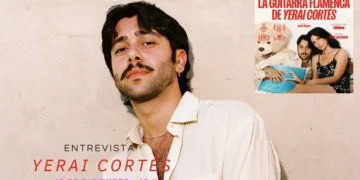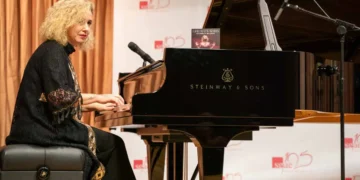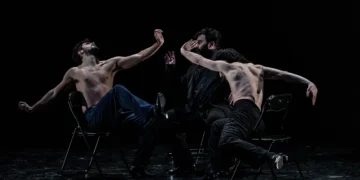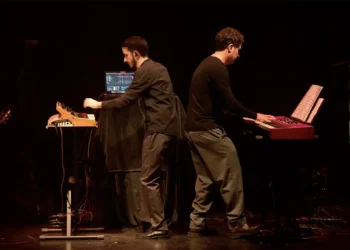|
49th Potaje Gitano de Utrera Tribute to Lolita Flores Saturday, June 25th, 2005. 10:30pm |
Cante: Esperanza Fernández, Miguel Funi, Manuel Requelo.
Dance: Antonio el Pipa and his group. Familia Farruco
Text and photos: Estela Zatania
The invention is 49 years old. It’s been nearly
a half-century since a small group of people in Utrera decided to
cook up a pot of bean stew, gather a few friends together and offer
a simple evening of flamenco to raise funds for Utrera’s brotherhood
of gypsies. Little could anyone have imagined that the inspired
idea would lead to hundreds of similar undertakings, and to a historical
era for flamenco: the festival movement.
Click to enlarge images
|
Lolita honored
|
El Barullo and La Farruca
|
From those humble beginnings, the festival has grown exponentially
to include all the major flamenco performers of each era, with tributes
to such relevant figures as Manolo Caracol, Antonio Mairena and
Pastora Imperio among many others, and reaching attendance of up
to three thousand.
Utrera: the flamenco essence, not as
a fleeting commerical phenomenon, but day-in, day-out food for the
soul..
This year some two thousand people arrived at the patio of the
Salesianos school to welcome in the summer with bean stew and flamenco.
Every program of every festival is a world unto itself with a specific
personality. This year’s Potaje was top-heavy with dance and
light on the cante, but it all fleshed out nicely in the end thanks
to the talent and enthusiasm of many local artists, not to mention
the town spirit which lives the essence of flamenco, not as a fleeting
commercial phenomenon, but day-in, day-out food for the soul.
The first part opened in a dignified manner por soleá, as
is only fitting in this land of soleá, with the wizened and
worn voice of local singer Manuel Requelo who also shined with his
siguiriyas and tangos, accompanied on the guitar by Ramón
Priego.
|
El Carpeta picks up the reins
|
Esperanza Fernández and Miguel
A. Cortés |
“That white scarf, that art and that command” announced
Alberto García Reyes to present Miguel Funi from Lebrija
who prologued his performance expressing anger at the current flamenco
scene. Then, like an elegant and inspired priest saying mass, he
delivered a malagueña-inspired song with Juan del Gastor
accompanying with sounds that recalled his hometown of Morón
de la Frontera and his uncle Diego. Between the two artists, it
was composure expressed in compás, a different vision of
flamenco, stylized, natural and tinged with a feeling of the interior.
Composure expressed in compás,
a different vision of flamenco, stylized, natural and tinged with
a feeling of the interior.
From Jerez, the impressive Antonio el Pipa, dressed in white, arrives
on stage with his customary high-quality backup. Singer Enrique
el Extremeño sings cantiñas with an Utrera sound,
his adopted town, for Antonio’s dance, and this is followed
by a friendly battle of wits por soleá between el Extremeño
and Juana la del Pipa, two voices for a potential artistic duo we’ve
enjoyed on other occasions. Antonio is in especially good form with
more control and subtlety than is customary in this dancer, and
the night is his. The number that Antonio always does with his aunt
Juana – classics don’t go out of style – intense
and profound, has the audience enthralled.
“Her mother is from Lebrija, her father from Triana”
says the emcee, reminding us of the experimental nature and open
mind of Esperanza Fernández who arrives on stage with Granada
guitarist Miguel Ángel Cortés. Cantiñas del
Pinini, siguiriyas, tientos tangos and bulerías, all polished
and studied and delivered with absolute respect. The lady fulfills
her duties many times over, but something is always missing. Miguel
Ángel’s accompaniment longs to take center stage and
the alternative tunings he employs soon wear thin from overuse,
but these are two seasoned professionals, no doubt about it. Esperanza’s
excellent dancing seems to fill the vacuum left by her singing.
|
Miguel El Funi
|
Antonio El Pipa
|
Next up, the tribute to Lolita Flores whose mother, the immortal
Lola, received the same honor at the sixteenth edition of the Potaje
in 1972. Lolita accepts diverse plaques and mementos thanking the
people of Utrera “with their different take on flamenco”.
She expressed her best wishes for Fernanda de Utrera and praised
the gypsy brotherhood for having maintained the world’s first
flamenco festival for so many years.
Juana and Antonio el Pipa – classics
don't go out of style – intense and profound
Time for the Utrera group, the perfect moment with the night air
bringing a distinct chill and the piping hot bean stew being served.
In this town “local amateur” is quite a mouthful, in
light of the magnificent assortment of voices and the abundance
of talent that characterizes the area. Colorful patriarch Cuchara
directs the ambience with the help of Manuel and José de
la Buena, Manuel Requelo, Diego Pantoja, Gaspar de Perrate, eldest
son of the legendary singer and many others.
The “icing on the cake” as we say on these occasions,
and never was the phrase more apt. The Farruco family, magnificent,
unique, masters of compás and permanent suppliers of the
best and most traditional flamenco dancing. Artistic director Farruquito
observing from the front row, and his face is a portrait of pride
and satisfaction. No longer are people confused by the various elements
of the family. Everyone knows the lead dancer is Farruco, fair-haired
younger brother of Farruquito, Barullo is the cousin of both and
Farruca, the mother of the two brothers. The guitar accompaniment
of Román Vicenti and Antonio Rey is red hot, as this sort
of dancing demands, and singer Mari Vizárraga is splendid,
one of the best female voices in flamenco today although she’s
relegated to the backup section which she handles skillfully.
In this town “local amateur”
is quite a mouthful, in light of the magnificent assortment of voices
and the abundance of talent
|
Manuel Requelo
|
An impressive a capella bulería prologues Farruco’s
dance with a romance compás. Farruquito’s younger brother
has the technique and intensity of the elder one, but is reminiscent
of Farruquito several years ago when youthful enthusiasm overshadowed
artistic sensibility. The younger boy is very conscious of his “sex
appeal”, he smiles broadly at the audience and is all fireworks.
For the time being he lacks the dark dignity of Farruquito which
is his most noteworthy quality. But Farruco is young and the members
of this family mature quickly.
La Farruca, mother of the two boys, is quite a dancer in her own
right, somewhat more conventional than her sons, yet she manages
to assert her personality with great clarity even sharing the stage
with two wonder-boys. The ending was literally electrifying –
had there been a sudden rain shower, the lights would have cut for
sure. Manuel el Carpeta, the family’s smallest dancer, continues
to grow as children do, and left many jaws agape with his command
and maturity.
The Farruco family: magnificent, unique,
masters of compás and permanent suppliers of the best and
most traditional flamenco dancing.
The bottom line is, this year we missed the presence of a major
singer, but the overall impression was excellent. I don’t
know whether it’s true that flamenco festivals are on the
wane as many young people say dreaming of a brave new flamenco world,
but if so, the news hasn’t reached Utrera yet, and word has
it that the Queen of Spain herself will be present next year to
commemorate the golden anniversary of the Potaje Gitano de Utrera.
More information:
Potaje 2003 – Review and
images
Potaje 2004– Review and
images
|
Pasión y Ley – DVD – Antonio El Pipa |
|
Esperanza Fernández |
|
Cultura Jonda 10. Potaje gitano de Utrera en directo |
|
Farruquito 1996 |





























